Peat Toilet Fillers: A Comparative Review and Selection Tips
Not everyone will want to engage in the equipment of an internal bathroom with a drain pit in cottages. Not satisfied with many and constant trips to the toilet in the yard. In recent years, an alternative has appeared - bio-nitase, installed directly in the room.
The fillers used in them for peat toilets are able to remove the smell and the need for continuous removal of waste. In this article we will talk about the principle of operation of toilets for toilets, consider their composition, and also make a comparative review of the most popular peat fillers.
The content of the article:
The scheme and principle of operation of the dry closet
There are many designs of dry closets: from 10-liter with a mechanical feed of peat to 200-liter with automated filling and an active ventilation system.
But the standard components of this equipment are:
- Housing with seat.
- Lower waste bin.
- Top container for filler.
- Vent pipe (optional).
- The mechanism of mixing filler and waste.
- Hose for draining the liquid fraction (optional).
Approximate scheme:
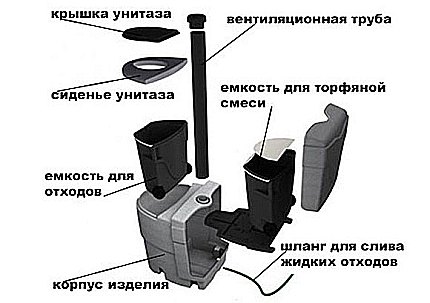
The operation of the dry closet is simple and straightforward. Initially, the peat mixture is poured to the top in a special container, as well as in a waste tank with a layer of 2-3 cm.
After visiting the toilet, turn the handle or lever of the internal mechanism so that an additional layer of peat is poured into the waste tank. The toilet may have a built-in electric drive that performs this procedure instead of a person. You can read more about the principles of operation of dry closets and their varieties. here.
The advantages of the dry closet are:
- mobility;
- ease of installation;
- low cost.
As the waste container is full, it must be pulled out and cleaned.The biomass formed in the toilets is perfect for fertilizing the land of a garden plot after composting.
Why do we need peat filler?
People who bought peat filler for dry closets do not think about the number of useful functions that this mixture performs. Everything is necessary to know about the capabilities of this product in order to use them with maximum economic benefits and efficiency.
The main objectives of peat mixes for dry closets are:
- Inhibition of the development of pathogenic bacteria and insect larvae in waste.
- Removing the unpleasant odor of ammonia and hydrogen sulfide in the bathroom.
- Liquid absorption.
- Biochemical processing of organic substances by bacteria.
Bacterial additives to dry mixtures contain special strains of microorganisms that process human waste with the formation of sludge and water. As a result, even the possibility of the appearance of ammonia and hydrogen sulfide odors is excluded.
In the process of bacterial activity, high molecular weight organic substances are processed into low molecular weight ones, which are an excellent substrate for the production of natural fertilizers. Right after peat toilet cleaning the obtained biomass cannot be used in the garden - it must undergo the composting process for at least 1 year.
There are other, general economic areas of application of peat filler for dry closets.
The mixture can be used as:
- The substrate for storing root crops in the cellar.
- Filler of toilet pots of animals.
- Subsoil protection of plant root systems in winter.
All options are popular due to their safety.
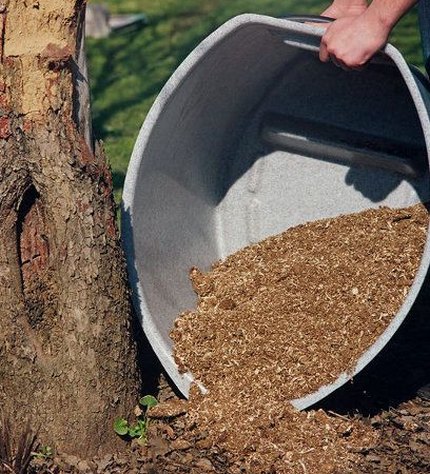
There are many more useful ways to use peat filling in the country than it might seem. These mixtures not only perfectly cope with their functions in dry closets, but can also be used for additional household needs.
The composition of the fillers for dry closets
The odor problem in dry closets is solved using several different in nature ways. All of them are based on filling the waste container with any substances.
It can be:
- Peat mix.
- Bacterial fillings.
- Chemical powder.
- Liquid filler.
- Sawdust.
Peat mix is best suited as a filler for suburban dry closets. It differs significantly from the substrate used as solid fuel. The main task of the filler is to eliminate odors and start the process of biochemical decomposition of waste.
In the composition of peat mixes for dry closets, which are available on the market, you can find such ingredients:
- A mixture of dry peat. This ingredient absorbs moisture and odors well, preventing them from entering the bathroom. Peat is the main volumetric part of the filler.
- Soil bacteria, trace elements and organic additives. These components are usually purchased separately from peat mixtures. They are poured into the tank of the dry closet with waste every few days and process organic biomass into compost.
- Sawdust and crushed bark of coniferous trees. This ingredient perfectly absorbs moisture and odors, fills the bathroom with a pleasant aroma and makes the mixture more dense and loose.
- A mixture of dry sawdust of deciduous trees. The main function of this component is to loosen the mixture. Chopped wood is biodegradable, therefore it is subsequently processed by bacteria and becomes part of compost.
All of them are of natural origin.
Some manufacturers add lime to peat, which helps to more quickly neutralize unpleasant odors. The reason for the poor aroma from the dry closet may be the use by the manufacturer of lowland peat, which does not have sorption properties.
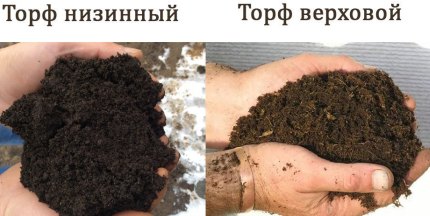
High-quality peat mixtures with microorganisms not only serve as a filler in the dry closet, but also are an excellent fertilizer for a summer cottage.
Advantages and disadvantages of mixtures
Before the purchase to the dry closet with peat fillers it is recommended to familiarize yourself not only with the positive sides of these mixtures, but also with the disadvantages. There are undoubtedly more positive moments.
These include:
- lack of unpleasant odors;
- good sorption properties;
- environmental friendliness;
- the ability to use waste as fertilizer;
- preventing the propagation of pathogenic microorganisms and insects;
- long shelf life of mixtures;
- ease of cleaning the waste tank.
It is also worth mentioning frost resistance - a relevant property for the northern regions.

These advantages allow peat mixes to constantly gain new market share in the country toilets thanks to word of mouth.
These fillers are not without a number of disadvantages:
- The need for continuous acquisition and delivery of peat mix.
- The failure of the toilet without filler.
- Limited shelf life, especially in mixtures with bacterial additives.
These shortcomings are not a problem if the region has free delivery of peat mixtures or if a person has his own car, on which he periodically drives to the city. Purchases of one 50-liter package should be enough for several months of using the dry closet.
Peat Filler Tips
There are no unified standards for determining the level of peat filler consumption. The more it is used, the less there will be unpleasant odors, but financial costs will increase.
The flow rate of the mixture is important to consider when buying a dry closet. If the whole family plans to stay in the house, then it is better to buy more bulky equipment, which will need to be cleaned once a month. When cleaning a large tank, it is not necessary to move its impressive structure to the street.
You can scoop and take out spent biomass in batches without worrying about unpleasant odors.
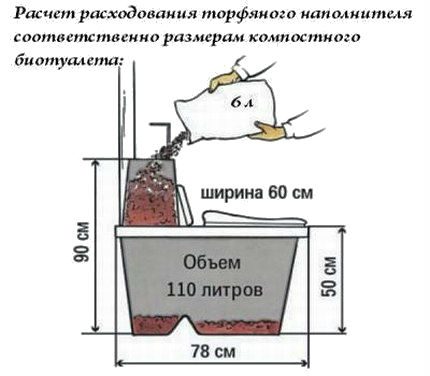
The recommended amount of the mixture to use after each visit to the toilet is 200-300 ml. Based on this norm, a 50-liter package should be enough for a month with two people using the toilet daily. The indicated volumes of use of peat filler can vary greatly, depending on the method of nutrition, weight and age of residents.
Comparison of popular brands of peat fillers
The basis of all peat fillers for dry closets is horse peat, but additional additives strongly affect the quality of the final product. The compositions of the most popular mixtures will be analyzed below.
Mix No. 1 - Kekkila (Finland)
The company produces two types of mixtures: Kekkila and Kekkila Hajusieppo.
Kekkila Hajusieppo mix consists of 60% high-quality sphagnum peat and 40% dry sawdust. Packed in perforated bags of 50 liters. The whole of each package is 15 kg. The recommended ratio of the mass of filler and waste is 1: 2.
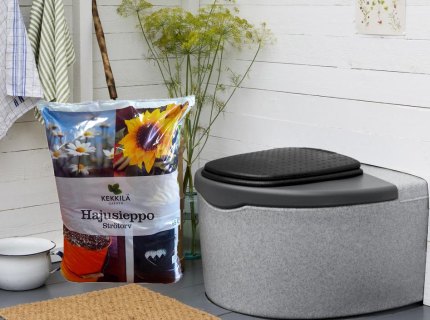
The Kekkila mix consists of 60% low level decomposition peat moss peat moss, 20% dry sawdust and another 20% pine bark. Packed in perforated bags of 50 liters. The whole of each package is 10 kg.
The recommended ratio of the mass of filler and waste is 3: 5. Due to the use of pine bark, the percentage of moisture absorption is slightly reduced, but the friability and flowability of the mixture increases with a large amount of liquid waste. The ventilated packaging prevents the mixture from caking and prevents the development of putrefactive bacteria in it.
Thanks to the use of dried sawdust, the percentage of moisture absorption in fresh mixtures reaches 80% of their original weight. Such indicators increase the effectiveness of the filler. Therefore, despite the price of a 50-liter package of 550-600 rubles, the long-term financial expenses for the maintenance of the dry closet are lower in comparison with cheap mixtures.
The manufacturer is not recommended to store the product at subzero temperatures, because it loses its sorption properties. After defrosting, the characteristics of the filler are restored. In large dry closets, it is recommended to mix the mixture in order to enrich it with oxygen and prevent decay processes.
Mix No. 2 - Piteco (Russia)
Peat fillers of this company are produced from Russian peat of low decomposition from the sphagnum group using Swedish technology. As a baking powder added wood sawdust, as a deoxidizing agent - dolomite flour. Also included are enzymes and microorganisms that accelerate the composting process.

Usually, bacteria are sold in separate packaging so that they do not begin the process of biodegradation of the excipient in packaged form. But Piteco decided to simplify the maintenance of the dry closet and created a technology that made it possible to combine peat, sawdust and bacteria without compromising on product characteristics.
The price of peat filler is 400-450 rudders for 50 liters or 15 kg. Peat mixes of this company are an excellent choice for thrifty people.
Mix No. 3 - Biolan (Finland)
This producer produces peat in Finland, and processes and prepares finished products in Estonia. The mixture is made of horse peat, clean chopped bark and sawdust of conifers. Recommended ratio of waste and filler 2: 1.
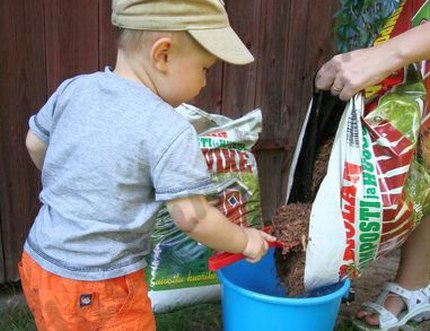
If there is an unpleasant odor from the dry closet or excessive humidity of the mixture in the waste tank, it is necessary to increase the consumption of the mixture by 25-30%.
There are no bacteria in the mixture, although its cost due to European production and imported Russian taxes is much higher than that of Piteco. The cost of a 40-liter package is 520-570 rubles. It is necessary to store the filler in a dry, warm room and be sure to tightly close the packaging if it is not immediately fully used.
Mixtures of this manufacturer are quite expensive, but their quality is at a high level.
Mix No. 4 - PeterPeat (Russia)
PeterPit mixes consist of ground peeled peat of Russian origin without additives. Shelf life is 3 years, although due to the lack of additional components, the mixture should not lose its properties after a longer period.
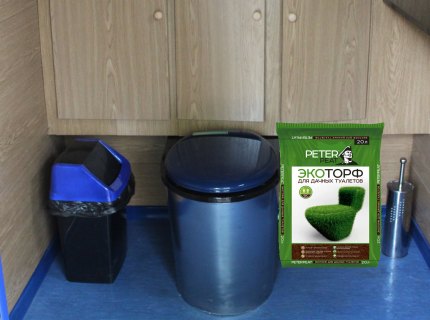
The manufacturer recommends storing the mixture at temperatures from -35 degrees below zero to +40 heat. If the filler was stored in the cold, then it must be thawed before use. The cost of a 50-liter package is 500-550 rubles, which is expensive for the mixture without any additional additives.
There are many other small producers of peat fillers on the Russian market, whose prices start at 300 rubles per 50 liter package. Cheap fillers are often made from transitional peat and do not contain additives. Because of this, the mixture formed in the dry closet has a lumpy structure, is prone to rot and smells bad.
The most acceptable price / quality ratio are Kekkila and Piteco, which offer proven quality at a good price.
Conclusions and useful video on the topic
The proposed video reviews will help ensure the simplicity of the device and the maintenance of dry closets. The process of using peat fillers practically does not differ from the recommendations of the manufacturer, therefore, these rollers will be enough to understand the use of any mixture.
The device of peat dry closet:
Filling peat dry closet with filler:
A comparative review of peat fillers for dry closets showed that there are fundamental differences in the composition of their ingredients. Preference should be given to products containing enzymes, microorganisms and dry sawdust. They cost a little more, but their consumption is less, and consumer characteristics are much higher.
Do you have personal experience using peat mixes for dry closets? Please share your experience, tell us which filler you use. Leave your comments - the feedback form is located under the flock.

 How to choose a dry closet for a summer residence: tips for choosing and an overview of the best models
How to choose a dry closet for a summer residence: tips for choosing and an overview of the best models 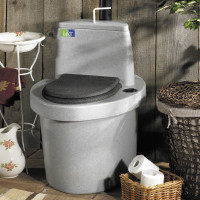 How to clean dry closets: features of cleaning peat and liquid varieties of dry closets
How to clean dry closets: features of cleaning peat and liquid varieties of dry closets  Rating of dry closets for a summer residence and a private house: popular models + recommendations for customers
Rating of dry closets for a summer residence and a private house: popular models + recommendations for customers  How to choose a tool for cleaning sewer pipes: a comparative overview of all types of tools
How to choose a tool for cleaning sewer pipes: a comparative overview of all types of tools 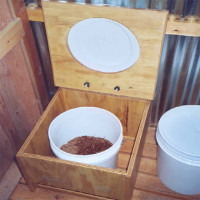 DIY dry closet: a step-by-step guide to the construction of a peat dry closet
DIY dry closet: a step-by-step guide to the construction of a peat dry closet 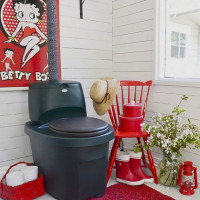 Which dry closet is better: liquid or composting? What to buy: peat or chemical option
Which dry closet is better: liquid or composting? What to buy: peat or chemical option  How much does it cost to connect gas to a private house: the price of organizing gas supply
How much does it cost to connect gas to a private house: the price of organizing gas supply  The best washing machines with dryer: model rating and customer tips
The best washing machines with dryer: model rating and customer tips  What is the color temperature of light and the nuances of choosing the temperature of the lamps to suit your needs
What is the color temperature of light and the nuances of choosing the temperature of the lamps to suit your needs  Replacement of a geyser in an apartment: replacement paperwork + basic norms and requirements
Replacement of a geyser in an apartment: replacement paperwork + basic norms and requirements
Indeed, the problem of toilets in private areas is quite relevant. The toilet itself is on the street, and it’s true that you don’t run into it much in the winter, and installing in the house is very problematic. From a simple dry closet there are a lot of unpleasant odors. I thought for a long time, and decided to install the peat variant. Of course, I had to tinker a bit, but still it was not so difficult, but now I'm sitting in the heat and without any smells.
We use the Piteko mixture, very satisfied. Initially, my grandmother bought a small dry closet for a summer house in the room, which is difficult to go out every time. There is no smell at all. Waste was used right there in the country as fertilizer. Then we started having problems with a street toilet made like a regular cesspool. They poured 2 kilograms of the mixture directly into the pit - the smell disappeared almost every other day.
They began to use this mixture as a cat litter. We fall asleep a little, change every day. There is no smell at all! And there is fertilizer)